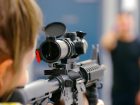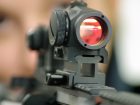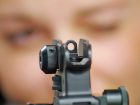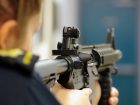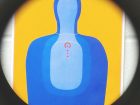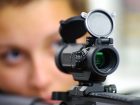
Features
Setting our sights on rifle optics
The fastest shooter in the world isn’t going to win too many gunfights. Neither will the most accurate shooter in the world. Speed without accuracy is a fast miss. Accuracy without speed means the gunfight is over before you get your boots on in the morning. (I think it was the ancient Chinese military strategist Sun Tzu who said that. Or perhaps it was Keanu Reeves in “John Wick.”)
December 14, 2018 By Dave Brown
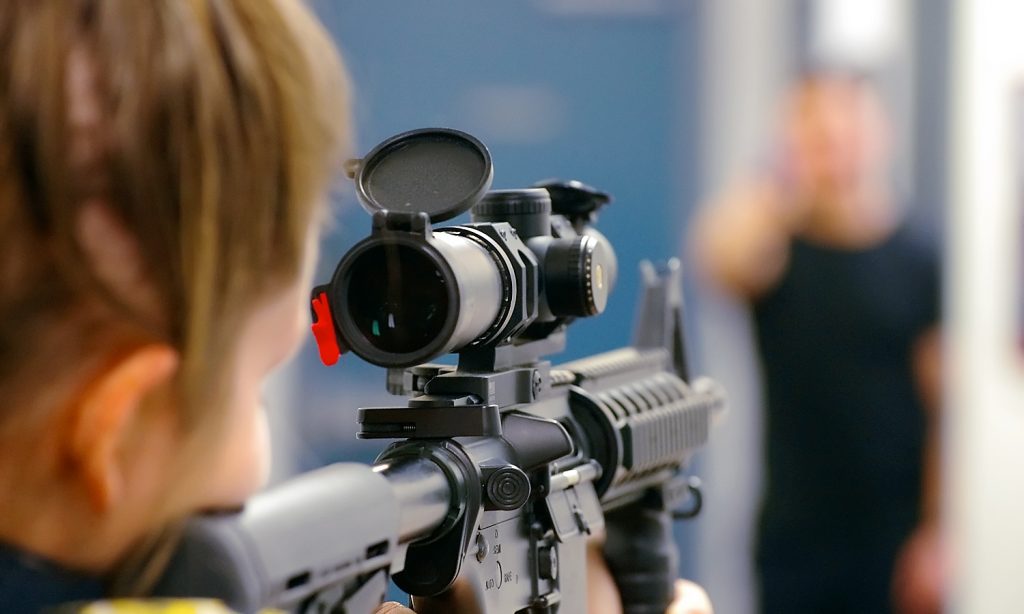 The Bushnell Elite Tactical 1-6.5x24mm rifle scope
The Bushnell Elite Tactical 1-6.5x24mm rifle scope In real life encounters, gunfights are won by the first person to put accurate rounds on target. When life is in balance and targets start shooting back, the faster an officer can stop a deadly threat, the more people get to stay alive.
One cannot trade away all their speed for accuracy, or vice versa. Officers use both elements in combination as the situation requires. This is not some Hollywood movie. In the real world, the winner of a gunfight gets to go home safe to their family; the second-place finisher doesn’t.
The patrol carbine
The police patrol carbine may be one of the greatest advancements in police defensive weapons. The carbine extends an officer’s range against active shooters all the way out from contact distance to 250 metres or more.
Handguns are more limited by the necessary design of the sights and the limitations of the human being struggling to keep those sights in alignment with each other. In actual combat, accuracy with a handgun can drop off dramatically after about seven metres.
Shotguns carry a greater impact, and can extend force response past 20 metres, while still keeping all their buckshot rounds on the target. They are also versatile, but a shotgun is less limited by its design and perhaps more limited by traditional training methods. Many officers today graduate from police college not appreciating the advantages of a good police shotgun.
This is where the police patrol carbine comes in. Intended as a quickly-deployed weapon for regular patrol officers, it is easy to shoot, inherently accurate and fast to both aim and shoot. In some circumstances, it is also safer for the general public.
Aside from the nature of the cartridge itself, one of the greatest advantages of the patrol carbine is the sight system. Sights can be configured in a variety of ways, and all contribute to greater accuracy in real life situations. Given enough time, all of them help an officer stop a deadly threat with near-surgical precision.
But is anyone ever given “enough” time in real life encounters? If the various choices in close- and intermediate-range sight systems are virtually equal for accuracy, the question then arises… which one is fastest?
That’s where Blue Line comes in. We tested four different sight systems for both speed and accuracy, using the firearms training simulator from MantisX.
The tests
Testing was done using volunteer subjects, all of whom had varying experience with a carbine. Some had cross-dominance issues. Accuracy standards dictated a minimum score of 80 per cent or more on every test.
While simulated scores cannot necessarily translate into real-world accuracy, live-fire testing of the MantisX training system has shown that this score should result in 80 per cent of all shots landing within the centre scoring ring of a standard RCMP qualification target at 100 metres.
Each subject was given a brief introduction into each of the four different sights and allowed a few seconds to practice shouldering from low-ready. Each subject was then timed and scored for 10 passes of one-round, dry-fire shots using the electronic trainer and results were recorded by the MantisX app on an iPad.
Average scores and times were recorded for all 10 passes, but the most significant times were considered to be the very first pass on each sight. This reflects real world conditions where the most important round to be fired is the first one. In other words, how fast can an average person, with no warmup and only 10 seconds to learn what the sight picture looks like, get 80 per cent or better on a target at 100 metres.
Firearms training simulators don’t necessarily reflect actual response times in combat, but each string’s first-shot times are probably a fairly close prediction on how long it might take in real life to shoulder and engage a deadly threat at 100 metres.
The sight systems
Sights for short and intermediate ranges typically encountered by a patrol officer need to be simple, fast and accurate within that design range. The maximum point-blank range of most police-issue 5.56mm ammunition zeroed at 50/200 yards, is any shot from the end of the muzzle out to approximately 250 yards, all staying within a six-inch circle with no hold over or hold under compensation needed.
Since range estimation is difficult in real-life encounters, optics designed to assist in range estimation are less useful on a patrol carbine than they are on a long-range rifle. This is why a good understanding of the concept of maximum point-blank range, combined with a dead-simple reticle design, results in a point-squeeze-hit scenario that stops gunfights cold with the first shot. With patrol rifle optics, simpler is better.
Iron sights
The term iron sight is used to describe the traditional front-and-rear sight system using two sights that must be kept aligned with each other and the target. On patrol carbines, the front sight is usually a vertical post and the rear sight is a circular aperture, forming what is sometimes termed a ghost-ring or peep sight. It is simple, robust and easy to use. The shooter focuses their eye on the front sight, and the rear sight forms a blurry ring. (Hence, the term ghost-ring.)
Of all the sight systems we tested, the iron sight probably generated the most surprising results. Always known for reasonable accuracy and speed in combat, iron sights were never felt to be as fast as a good red dot.
Well, our speed tests disagreed. First-shot times for each string resulted in speeds only .2 to .5 seconds slower than the fastest sight (the Primary Arms 1X Compact Prism Scope). The results were consistent across most of our test volunteers.
The sole glitch was cross-dominant shooters with previous military experience who tried to use their left eye on their right shoulder like they were once taught in the military. It didn’t work. But with practice and correct adaptation techniques, their times fell to within the average for all subjects.
Aimpoint red dot sight
The Aimpoint red dot sight is probably the most popular choice of sight systems for patrol carbines in Canada. While every sight comes with compromises of some kind, the combat-tested Aimpoint has probably the fewest. It’s tough enough that you could drive over it 10 times with your police SUV and the rifle would break long before the sight, and the battery life is measured in years. (Switch it on when first issued, you simply replace the battery every year before qualifying and never worry about it again.)
It uses a single centre dot, adjustable for brightness. Point-of-impact does not change, even if the dot is off centre, meaning it can be mounted slightly high or low and still be accurate. Because it does not magnify the image, there is no critical eye relief distance and it can be mounted virtually anywhere on the rail.
The one downside to the Aimpoint is that, like all red dot sights, older shooters are going to struggle with the sight picture. The problem of astigmatism and red dot sights was discussed in Blue Line’s December 2016 issue. Officers with aging eyes are often going to see a fuzzy cluster of dots instead of a single bright dot. The number of dots and size of the cluster will even vary, depending on many factors, including something as simple as the amount of sleep one secured the night before.
In our speed tests, younger shooters tended to be fastest with the Aimpoint, while older shooters like myself needed a fraction of a second more. On average, it was still both fast and accurate. Within the design range of a patrol carbine, the multiple dots as seen by some shooters did not seem to affect accuracy in any significant way.
Tactical scope
The Bushnell Elite Tactical 1-6.5x24mm rifle scope is the largest and heaviest optic in our group. It is extremely well built – and comes with a price to match. The clean and drop-dead-simple illuminated reticle helps guide the sight to the centre of the target and when dialed down to one-power, it is both fast and accurate.
For shooters with astigmatism, this was their favourite sight. The focus can be adjusted to needle sharpness for each individual shooter using a rear diopter, meaning no one will need to stop long enough to find their eyeglasses.
Because it uses optical lenses to magnify the image of the target, the scope has a narrow eye-relief distance. This requires precise mounting and the acceptable range from eye to rear lens is quite narrow.
Top quality 1-6X and 1-8X scopes have become popular among carbine shooters because, at the one-power setting, shooters treat it much like a red dot sight and keep both eyes open with the focus on the threat. This is why the tactical scope at one-power averaged fewer than 0.2 seconds off the pace of the fastest sight system.
1X Prism sight
The Primary Arms 1X Compact Prism Scope with the illuminated ACSS Cyclops reticle is the latest design from Primary Arms. It fills a void in the world of patrol rifle optics – the one-power scope with an illuminated reticle etched on glass, and specifically designed for short and intermediate range confrontations. It also turned out to be the fastest sight system with the majority of our test subjects.
Because of the optical lens design, it requires mounting for a specific eye relief, although in actual practice eye relief was very forgiving, ranging anywhere from 3.75 all the way out to six-inches. If power to the illuminated reticle is lost, the black reticle is still visible, and a diopter adjustment means it is forgiving for nearly every shooter’s eyesight.
The fraction of a second longer it took to place the eye at the correct distance from the rear lens was easily made up for by the speed of the reticle. It uses a tiny centre triangle, with the upper tip of the reticle representing the exact aiming point, and a horseshoe-shaped outer ring to enhance speed.
With an expert shooter, one could fire an accurate first round from low ready in under 1.2 seconds. Average shooters maybe took only about one second longer to acquire a sight picture and fire an accurate shot.
For shooters with astigmatism, it is also a good solution. While there are other one-power prismatic sights on the market, none of them ever tested by Blue Line completely eliminated astigmatism issues as effectively as the Primary Arms prism scope.
While distance from lens to eyeball was not as critical as magnifying scopes, height of the mount was far less forgiving. The factory mount was about eighth-of-an-inch too low for most shooters. Because of the optical design and parallax error, having a reticle appear slightly higher or lower in the tube can affect the impact point. Primary Arms sells an accessory mount that raises the sight a tenth of an inch and co-witnesses with most AR iron sights, but the quality of the accessory mount was more suited to airsoft guns than a rifle that may be needed to save your life.
The rotary switch was also very stiff, and lacked the hard stop of the Aimpoint switch. To turn the sight off, you rotate it all the way around, hopefully stopping at the almost indiscernible number zero on the dial.
While users really loved the combination of speed and accuracy, most found the Primary Arms centre triangle too tiny and the reticle too busy for a short- to intermediate-range carbine. I would have much preferred the plain circle-and-dot reticle found on EOTech holographic sights. Having tiny ranging lines etched onto the glass seemed like an unnecessary complication when bullets start flying in your direction.
A good first attempt, I hope Primary Arms continues to refine the prism scope. I would love to see a brighter reticle, longer battery life (mutually exclusive, I know) and a much simpler reticle design.
The whole point of optics on a patrol rifle is not target ranging, long-range accuracy, or a scope that will help you lead a target, make you lunch and call your spouse. It should be designed to be simple and fast.
After all, military strategist Sun Tzu said that the best battle is the one never fought in the first place. With a modern patrol carbine and the latest technology in tactical optics, the second-best battle is the one that is fought and won quickly.
MARKSMANSHIP – THERE’S AN APP FOR THAT • A look at the MantisX Firearms Training System
As firearms instructors, we use multiple tools at our disposal to teach simple concepts that are nevertheless difficult to master. These tools are designed to enhance training, not to become the instructor. The MantisX Firearms Training System is an excellent example of how we can use modern technology to make up for the limitations of humans, and use humans to make up for the limitations of technology.
Learning to shoot firearms with the speed, accuracy and responsibility inherent in being granted the highest level of force possible is not an easy task. There are specific reasons why officers are trained using the science behind modern police firearms training and why they need to continually reinforce basic technical skills that keep them and others alive.
Of the basic technical skills – grip, stance, sight picture, trigger control, reload and draw from the holster – most critical to accuracy is not the sights, as most people first guess; it’s trigger control. This is where the MantisX comes in.
The MantisX system consists of a sensor with compact gyroscopes that track the minute movements of a firearm from sight acquisition to trigger break, and an app that provides feedback on a tablet or smart phone. The $150 U.S. sensor mounts on most standard pistol, rifle or shotgun rails, and pairs with the free app over Bluetooth.
A golf simulator may help you practice your game indoors but when you drive the green on that simulated par three, it doesn’t tell you what you did to get there, or more important, how to do it again.
Unlike other trainers that utilize lasers mounted on the firearm and a laser-sensor on a target, the MantisX does not use lasers or require any special targets. Shooters can mount the sensor unit on almost any firearm, and it can track multiple shots and multiple targets through dynamic exercises or dry- and live-fire drills.
It analyzes the microscopic motions of a firearm during the actual trigger pull. The sensor detects the hammer fall or trigger click, and tracks the tiny movements of the muzzle before, during and after the trigger break to evaluate shooting performance and track progress of the shooter over time. It even works on CO2 pistols.
The app tracks shots and shot strings and plays them back on a variety of screens, the most useful of which is probably the computerized trace showing you microscopic movements of the muzzle while sighting (blue trace), during trigger pull (yellow trace) and after the shot break and recoil pattern (red trace.)
MantisX is constantly updating the app and improving features. New exercises are added on a regular basis and you can even attempt the 60-round FBI Qualification Course of Fire and compare your scores to others in your online group.
GOOD GUIDANCE
Marksmanship is not just aiming a gun. A big part of it is maintaining that aim through a smooth and consistent trigger pull, from the moment you acquire a sight picture to the moment the bullet leaves the barrel. The MantisX shows you exactly what you were doing before, during and after that trigger pull.
It doesn’t replace an instructor. In fact, if I was forced to identify a weaker area in the system, it might be the built-in coaching tips it provides to try to correct fundamental errors, some of which have less application to modern, two-handed shooting techniques.
This is where an experienced instructor really comes in. No electronic training simulator can analyze your mistakes and correct them for you. Just as one doesn’t become a firearms instructor by reading books and watching a few videos, one doesn’t become a good shot without constant practice of fundamentals under stress.
Few officers do enough dry practice. The strength of the MantisX system is not just how well it illustrates the importance of a proper grip and trigger pull. It also has the ability to prove that a live-fire score on the range is not just there to check off a qualification box; good scores are the result of proper techniques honed through both live- and dry-fire practice.
Practice doesn’t make perfect. Only perfect practice makes perfect.
(*This story originally appeared in the December 2018 edition.)
Dave Brown is Blue Line’s firearms and police vehicle contributor. He is a tactical firearms trainer and consultant based in Winnipeg, Man. He can be reached at davebrown@blueline.ca.
RELATED STORY: “Duty firearms 2018 – New trends in police and law enforcement guns and ammo“
Print this page
